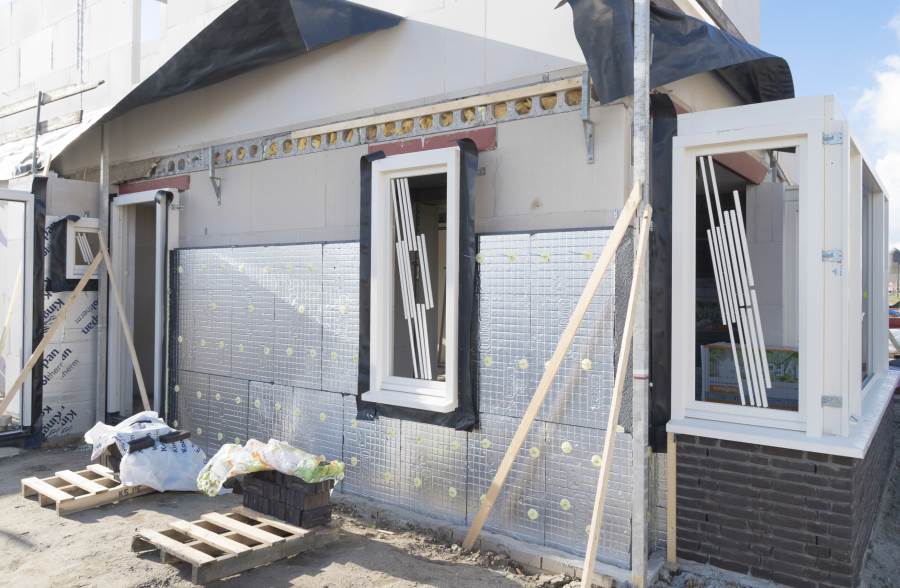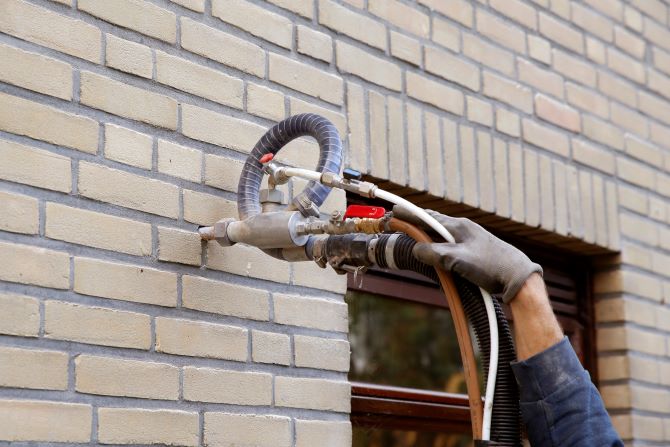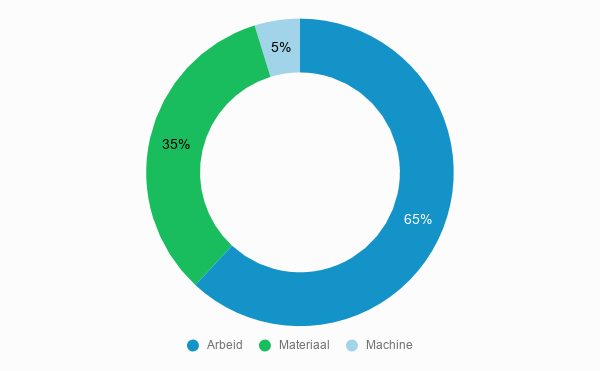Are you, like many others, planning to opt for cavity wall insulation so that you can enjoy your home to the full? Or has your home already had cavity wall insulation in the past, but you want to replace the insulation? To make the preparation for this modification of your home worry-free as well, Renoca has collected price information for you.
What does cavity wall insulation cost?
On average, having cavity wall insulation installed for a corner house costs £2,000. This will obviously be cheaper for a terraced house and more expensive for a detached house. Besides the surface area to be insulated, the total insulation prices also depend on the type of insulation material (e.g. glass wool, EPS beads, PUR foam or rock wool) used. See the cost overview below for an indication of average prices for cavity wall insulation, including installation.
| Type of house | Glass wool / Rock wool | EPS | PUR foam | |
|---|---|---|---|---|
| Appartment (25 m²) |
£ 375 -£ 500 | . £ 500 | £ 500 – £ 625 | £ 625 |
| Tween Apartment (50 m²) |
£ 750 – £ 1.000 | £ 1,000 – £ 1,250 | £ 1,250 | |
| Corner house / semi-detached (100 m²) |
£ 1,500 – £ 2,000 | £ 2.000 – £ 2,500 | £ 2,500 | |
| Detached house (180 m²) |
£ 2,700 – £ 3,600 | £ 3,600 – £ 4,500 | £ 4,500 |
Find the best specialist for your project and get free quotes.
Start
What is the payback period for cavity wall insulation?
A well-insulated house not only provides more living comfort, you also save on your energy bill every year. An investment in cavity wall insulation is a relatively cheap insulation method as it is quick to install and requires little finishing. Cavity wall insulation therefore generally pays for itself within 3 to 5 years. With the help of subsidies, this period can even be shorter.
Price examples
We explain the above table of average prices based on a few situations. This will give you a better idea of the possible total costs, depending on your living situation and wishes.
Costliest option
You are looking for the cheapest form of cavity wall insulation for your flat. Then the choice will soon fall on insulation with glass wool. This type of insulation is the most cost-effective, as it is fitted to a terraced house with 50 m2 of cavity wall, for example, starting from £1,000. Glass wool is made from recycled glass, making it a conscious choice.
Highest insulation value
Are you looking for the best insulation solution for the insulation of your semi-detached house? Then opt for PUR foam. PUR is the most expensive material, but then it also has the highest insulation value. The foam spreads well in the cavity, allowing little cold to pass through. Cavity wall insulation with PUR costs around £2,500 for a 100 m2.
An average project
EPS beads are also known as Styrofoam. They are produced in an environmentally friendly way and are quite affordable. Do you choose this insulation material for the cavity walls of your terraced house? If so, you will spend an average of £1,000 to £1,250 for 50 m2.

Is my house suitable for cavity wall insulation?
Before you can make any choices around cavity wall insulation, it is important to first look at the current state of your house. Is your home suitable for cavity wall insulation? Is the house perhaps already insulated and what could you improve?
Homes built before 1920
First of all, the year of construction of your house says a lot about insulation. Do you own a house built before 1920? These houses often do not have a cavity wall and therefore cannot be insulated with cavity wall insulation. However, there are other options for insulating such homes: with pre-walls on the inside, or through insulation against the outside of the house. This is called facade insulation.
Homes built after 1920
With newer homes, the degree of insulation will vary. For example, houses built before 1975 are often poorly insulated during construction, while houses built after 2000 generally have reasonable to good insulation.
However, older houses may not have been insulated at the time of construction, but afterwards by previous residents. Even then, it is worth checking what could be improved about the insulation. Cavity wall insulation installed in the 1990s, for instance, may now be of insufficient quality. Also, the compulsory insulation values were lower then, so with new cavity wall insulation you can still improve energy and cost savings.
Wall thickness
Not only the year of construction of the house says something about the presence of a cavity and cavity wall insulation, the thickness of the wall is also a good indication. At the front or back door, you can measure how thick your exterior walls are. Is this less than 24 centimetres? Then your outer wall has no cavity space. If your exterior walls are 24 centimetres or thicker, you probably do.
What types of cavity wall insulation materials are there?
As mentioned in the table at the top of this article, there are different materials that are suitable for cavity wall insulation. Which type is most suitable for your home depends on your preferences and budget. We briefly list the pros and cons of the most commonly used types.
Glaswool
Glaswool consists of a combination of glass that is ground and melted and a binding agent with sand. It is an environmentally friendly choice, moisture- and mould-resistant, non-flammable and soundproofing. In cavity wall insulation, the blow-in wool is gradually distributed throughout the cavity wall, preventing the material from collapsing and providing optimum insulation.
Glaswool does not dissolve in water, but it does lose its insulating properties once it gets wet. The material also causes itching and irritation when it comes into contact with skin. Therefore, always wear protective clothing, a mouth mask and goggles when processing this material.
EPS beads
The term EPS stands for expanded polystyrene, but is best known to many as Styrofoam. This material is very lightweight as it consists of 98% air and only 2% polystyrene. The stagnant air makes EPS a good insulator. EPS beads are injected into the cavity wall together with glue so that the beads stick together and any subsidence is prevented.
EPS is recyclable, insensitive to moisture and free of mould and rot. It does not cause skin irritation. Despite EPS being recyclable, the raw material in EPS is a plastic and not a natural material. EPS is also flammable, although it does act as a fire retardant.
PUR foam
PUR is short for polyurethane and is created by a chemical reaction of different substances. The foam easily seals seams and cracks and therefore provides a very high insulation value. It can also be applied quickly and is particularly suitable for hard-to-reach areas or heavily soiled cavity walls.
PUR foam is moisture-resistant, does not suffer from mould and is fire-retardant.
PUR is not environmentally friendly: it is a chemical product and installing PUR foam therefore releases toxic fumes, which also give off a chemical smell. Therefore, always have it installed by a certified specialist and choose PUR without HFCs as a binder. The material adheres well, making the material difficult to remove.
Steeth wool
Steeth wool is made using volcanic rock. This makes it a natural material and fully recyclable. Like glass wool, it falls under the mineral wool types, although stone wool is just slightly more expensive. Stone wool does not suffer from mould, is very sturdy, flexible and provides good acoustic insulation as well as thermal insulation. It is also fireproof and outperforms glass wool in this.
Like glass wool, the fibres in stone wool cause itching and irritation when working with this material. Therefore, use protective clothing and wear a protective mouth mask and safety goggles. In addition, stone wool is not resistant to moisture and wet stone wool can cause the insulation to sag. The material should therefore be protected against this.
Other insulation materials
In addition to the above commonly used insulation materials, you can also choose, for example, flax insulation, UF foam, perlite granules or organic insulation materials such as cork, wool or sawdust chips. Need more information? Read all about the options in our Cavity Wall Insulation article.

Subsidy scheme around cavity wall insulation
The investment in insulation can be quite pricey. Because the government recognises this and considers insulation important, you can claim subsidies from the government through the ISDE scheme. There are also local subsidy possibilities. You can check whether your municipality, province or water board has subsidies for insulation via the Energiesubsidiewijzer.
Conditions for ISDE subsidy
To receive a subsidy through the ISDE scheme for private individuals, you must meet some conditions. Previously, you were only entitled to a subsidy if you took two insulation measures, or combined an insulation measure with a solar boiler, heat pump or connection to a heat network. Since 1 January 2023, you can also apply for a subsidy if you took one insulation measure. However, this measure must have been taken after 1 April 2022. If you meet all the conditions, you can receive around 15% subsidy.
Do you still choose to take a second measure within 24 months of the first insulation measure? Then the insulation amount for the first measure will be doubled and you will still receive around 30% subsidy.
Some of the conditions are that you must be the owner of the house and live in it. Furthermore, you need to hire an insulation company to have the insulation installed, because if you do it yourself you cannot apply for a subsidy. Would you like detailed information on the conditions for the subsidy and the exact subsidy amounts? You can find this on the website of the RVO.
You may combine the subsidy from the government with local subsidies. You can also combine the ISDE subsidy with a loan, for example the Energie Savings Loan.
How are the cavity wall insulation prices built up?

The costs for cavity wall insulation consist of labour costs, machine costs and material costs. The structure of the cost of cavity wall insulation varies depending on the choices you make. As a rule, labour costs will account for the vast majority of the total price, but there are exceptions.
When using PUR, for example, the material cost is a relatively larger part of the total price. The material itself is more expensive and the number of labour hours is actually lower with this material. As a result, the increase in total costs is not as large as you might expect.
Do you want to know for sure how much cavity wall insulation will cost in your situation? Get quotes for specific price information for your project.
What are price-determining influences?
Choosing cavity wall insulation, there are things that directly affect the price. We will mention a few.
Current state of the (cavity) wall
Is there a cavity wall in your home and is it therefore possible to apply cavity wall insulation? Without a cavity wall, facade insulation is the right choice.
If the cavity wall is there, the question is whether it already has insulation. If so, what condition is the current insulation layer in? In case of soiling or subsidence, for example, this may have to be removed from the cavity first. This will incur additional costs. The current condition of your house is therefore the first factor that will influence the price. Each material has its advantages. The best option depends on your needs. Therefore, think about which characteristics are most important to you and discuss with the specialist which material is the best choice for you.
Combining insulation measures
The total cost of insulating your home also depends on whether you want to combine insulation measures with each other or not. If you choose to have floor insulation done in addition to cavity wall insulation, for example, the total price will be higher. If you take two insulation measures, you are entitled to a subsidy. Your house will also become more energy efficient, which will save you money in the long run.
Extra options
As with all activities, there are extra options available for insulating your house. These options are not necessary, but can complete the modifications to your home.
| Extra option | Average price | Benefit |
|---|---|---|
| Gable impregnation | £900 | Good against moisture intrusion |
| Ventilation grids | small – £15 Large – £60 |
Better ventilation, house warm faster so less heating costs |
| Central heating | £6.000 (incl. radiators) | Most efficient way of heating |
Find the best specialist for your project and get free quotes.
Start